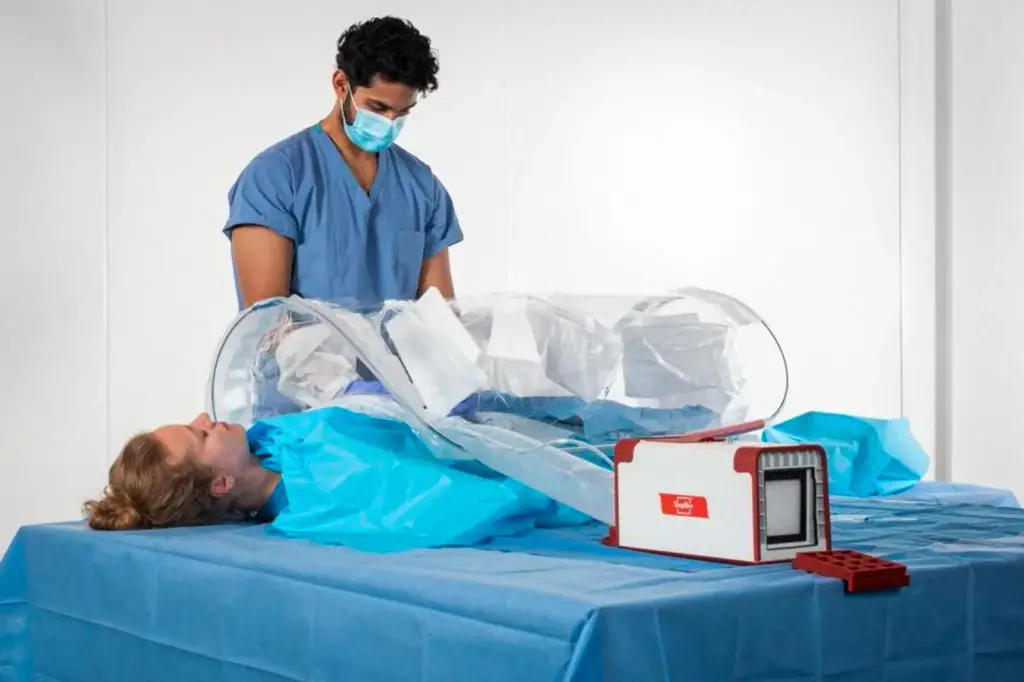SurgiBox: Portare la Chirurgia Sicura a Pazienti Ovunque – Dimostrato con Successo in Ucraina

La startup SurgiBox, sostenuta dal MIT D Lab, ha sviluppato un kit portatile che i medici possono utilizzare per creare ambienti operatori sterili in contesti a bassa risorsa. Il sistema SurgiBox include una bolla con buchi per le braccia rivolti verso l'interno, un modulo che filtra e controlla il flusso d'aria e una batteria. Il tutto si adatta in uno zaino e può essere allestito in pochi minuti. Crediti: Cortesia di SurgiBox
La startup SurgiBox, sostenuta dal MIT D-Lab, ha sviluppato un kit portatile che i medici possono utilizzare per creare ambienti operatori sterili dove sono più necessari.
SurgiBox, un'azienda in collaborazione con il D-Lab del MIT, ha sviluppato un sistema chirurgico portatile per garantire un accesso chirurgico sicuro in aree prive di sale operatorie sterili, un concetto che è stato dimostrato con successo durante una missione umanitaria in Ucraina.
A marzo, due furgoni pieni di medici e forniture mediche hanno attraversato il confine polacco per raggiungere Kiev come parte di una missione umanitaria. Entrambi i furgoni erano pieni di forniture mediche tradizionali di cui il paese ha disperato bisogno, come lacci emostatici, bendaggi e kit di sutura. Ma uno dei furgoni ha trasportato anche circa 50 unità di un sistema completamente nuovo che rende possibile eseguire un'operazione chirurgica in sicurezza in luoghi senza sale operatorie sterili.
I sistemi sono stati progettati da SurgiBox, una startup che ha lavorato molto con il MIT D-Lab per oltre un decennio, e promettono applicazioni molto oltre le zone di guerra. La maggior parte della popolazione mondiale non ha un accesso immediato alle sale operatorie e in situazioni come il maltempo e altre calamità naturali, le operazioni sanitarie possono essere interrotte proprio quando sono più necessarie.
Il sistema SurgiBox include una bolla con buchi per le braccia rivolti verso l'interno, un modulo che filtra e controlla il flusso d'aria e una batteria. Il tutto si adatta in uno zaino e può essere allestito in pochi minuti.
"Stiamo cercando di portare la chirurgia sicura ai pazienti che ne hanno bisogno", afferma la fondatrice di SurgiBox, Debbie Teodorescu, che è anche una ricercatrice affiliata al MIT D-Lab. "In questo giorno e età, al di fuori di una porzione molto piccola del mondo, è molto difficile eseguire un'operazione chirurgica in sicurezza. Puoi avere gli stessi medici, le stesse eccezionali competenze, ma se ti mancano le strutture e le attrezzature, non puoi offrire lo stesso livello di assistenza."
Per la donazione in Ucraina, il team di SurgiBox è volato in Polonia, ha atteso in una lunga coda al confine ucraino, e poi si è diretto per diverse ore verso Kiev, dove hanno affrontato allarmi di raid aerei a tutte le ore mentre istruivano i medici su come utilizzare il sistema.
Il viaggio è stato arduo e ha dato al team di SurgiBox una nuova comprensione delle difficoltà quotidiane degli ucraini. In molti modi, è stata anche la culminazione di un percorso molto più lungo che è iniziato con un'idea che Teodorescu aveva nel 2009.
Da sinistra: Michael Samotowka MD (HCA Healthcare), Emanuele Lagazzi MD (MGH) e il co-fondatore di Surgibox, Mike Teodorescu. "Pensiamo che SurgiBox potrebbe essere utilizzato per abbassare i costi sanitari e dare anche ai medici e ai pazienti maggiore flessibilità", afferma Mike Teodorescu. Crediti: Cortesia di SurgiBox
Teodorescu era una studentessa dell'Università di Harvard quando si è per la prima volta coinvolta con D-Lab come parte di un progetto di ricerca intorno al 2009.
"Era un ambiente così amichevole e accogliente, e alla fine del progetto hanno detto: 'Se stai lavorando su qualcosa o vuoi scambiare idee, siamo la tua gente' ", ricorda.
Poco dopo quell'esperienza, ebbe l'idea di SurgiBox lamentando quanto fosse difficile condurre la chirurgia in sicurezza in gran parte del mondo.
"Ho pensato: 'Siamo in grado di proteggere i nostri esperimenti ovunque sia necessario utilizzando le campane a guanto, perché non possiamo fare lo stesso per i pazienti?' "rammenta Teodorescu. "Ecco come SurgiBox è venuto alla luce: una campana chirurgica. Ora, non è proprio una campana e non includiamo i guanti, ma il concetto è lo stesso: puoi fornire protezione ai pazienti sul punto di necessità".
Per perseguire quella visione, Teodorescu è tornata subito al D-Lab, dove ha iniziato a lavorare con persone tra cui Dan Frey, direttore della ricerca accademica all'epoca; Jack Whipple, responsabile del laboratorio ed istruttore tecnico Dennis Nagle, scomparso nel 2020. Gli studenti del D-Lab hanno anche affrontato i primi problemi di progettazione e di business per SurgiBox come parte delle loro tesi di laurea magistrale e triennale e come progetti di squadra nei corsi 2.722J (D-Lab: Design) e 2.729 (Design for Scale). Un altro ex studente del D-Lab, Macauley Kenney SM '16, è attualmente il chief operating officer di SurgiBox oltre a ricoprire il ruolo di docente al MIT.
“D-Lab is really an amazing place,” says SurgiBox CEO and co-founder Mike Teodorescu, who met Debbie as a student at Harvard and also worked at D-Lab as a visiting scholar for two years. “I’ve been at four universities as a student and professor, and I have to say D-Lab is really unique. It’s really welcoming, and if you’re working on something to help make lives better for people and if you’re tackling a major humanitarian problem, they welcome you.”
The design SurgiBox’s team eventually settled on is compact and lightweight while also mimicking the environment of an operating room.
“Surgeons don’t want to change their workflow,” Debbie Teodorescu says. “It’s already a huge cognitive burden to do surgery. They don’t want to deal with things that increase that cognitive burden. We’re preserving their workflow by saying, ‘You’re going to treat the patient the way you’d treat them for surgery anyway. You’re going to more or less flip a switch to turn the system on, and then you stick your arms through just like you’re wearing a gown, and begin the surgery.’”
Last month’s Ukraine donation was one of several that SurgiBox has made to the country. After the first, the Ukraine Operation Command South sent back a letter thanking the company for saving 31 lives and asking for more. SurgiBox’s team realized that because of damage to health care infrastructure around the country, Ukraine’s civilian doctors were also using the system for situations like childbirth and to treat issues like gallbladder infections and appendicitis.
For the latest donation, Mike Teodorescu traveled to Kyiv with Michael Samotowka, a surgeon with the charitable organization MedGlobal and with HCA Florida Healthcare, and Emanuele Lagazzi, a clinical research fellow at Massachusetts General Hospital, both of whom had previously traveled to Ukraine on aid missions.
“I want to especially thank [Samotowka and Lagazzi] for their ongoing humanitarian work, as well as credit nonprofit organizations like MedGlobal, which provide critically needed assistance to disaster and war-affected regions,” Mike Teodorescu says.
SurgiBox is now ramping up production of its systems ahead of its second medical device certification from the European Union and an official product launch across the 28-country bloc this summer. SurgiBox’s first full production batch will go to Doctors Without Borders.
In the long run, SurgiBox’s team believes the system could be used to conduct surgery at patient bedsides if patients are elderly or especially vulnerable to infection. They also note that in some countries, doctors drive around in ambulances, and SurgiBox could be used to perform mobile surgeries.
More broadly, they also see the system as an inexpensive alternative to operating rooms for many procedures.
“We think SurgiBox could be used to lower health care costs and also give doctors and patients more flexibility,” Mike Teodorescu says. “There’s a whole set of costs associated with cleaning the operating room, getting it ready for patients, and getting the patient prepped for the operating room. Having some of that at a patient’s bedside would be hugely beneficial.”




